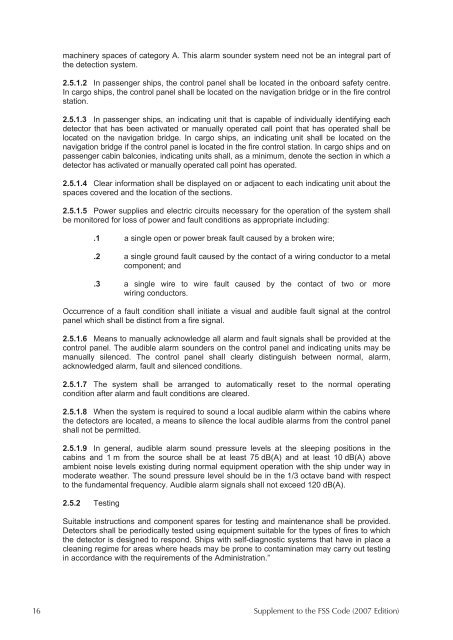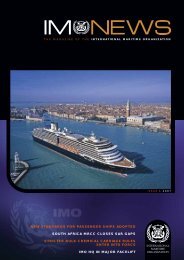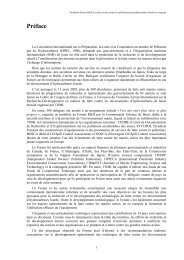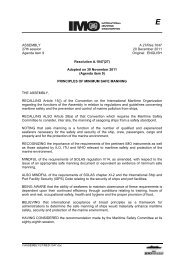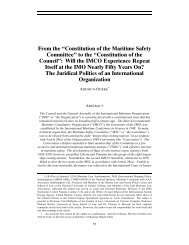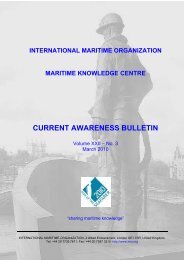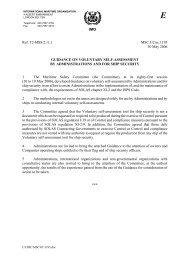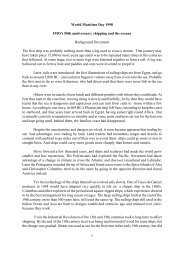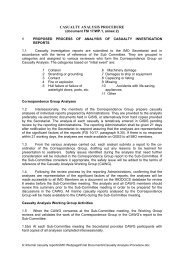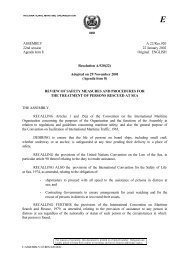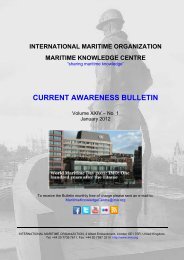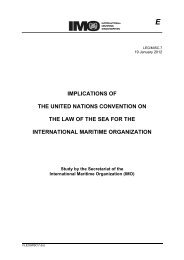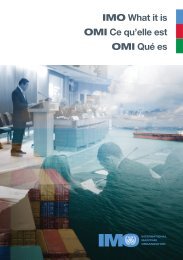Supplement: FSS Code - IMO
Supplement: FSS Code - IMO
Supplement: FSS Code - IMO
Create successful ePaper yourself
Turn your PDF publications into a flip-book with our unique Google optimized e-Paper software.
machinery spaces of category A. This alarm sounder system need not be an integral part of<br />
the detection system.<br />
2.5.1.2 In passenger ships, the control panel shall be located in the onboard safety centre.<br />
In cargo ships, the control panel shall be located on the navigation bridge or in the fire control<br />
station.<br />
2.5.1.3 In passenger ships, an indicating unit that is capable of individually identifying each<br />
detector that has been activated or manually operated call point that has operated shall be<br />
located on the navigation bridge. In cargo ships, an indicating unit shall be located on the<br />
navigation bridge if the control panel is located in the fire control station. In cargo ships and on<br />
passenger cabin balconies, indicating units shall, as a minimum, denote the section in which a<br />
detector has activated or manually operated call point has operated.<br />
2.5.1.4 Clear information shall be displayed on or adjacent to each indicating unit about the<br />
spaces covered and the location of the sections.<br />
2.5.1.5 Power supplies and electric circuits necessary for the operation of the system shall<br />
be monitored for loss of power and fault conditions as appropriate including:<br />
.1 a single open or power break fault caused by a broken wire;<br />
.2 a single ground fault caused by the contact of a wiring conductor to a metal<br />
component; and<br />
.3 a single wire to wire fault caused by the contact of two or more<br />
wiring conductors.<br />
Occurrence of a fault condition shall initiate a visual and audible fault signal at the control<br />
panel which shall be distinct from a fire signal.<br />
2.5.1.6 Means to manually acknowledge all alarm and fault signals shall be provided at the<br />
control panel. The audible alarm sounders on the control panel and indicating units may be<br />
manually silenced. The control panel shall clearly distinguish between normal, alarm,<br />
acknowledged alarm, fault and silenced conditions.<br />
2.5.1.7 The system shall be arranged to automatically reset to the normal operating<br />
condition after alarm and fault conditions are cleared.<br />
2.5.1.8 When the system is required to sound a local audible alarm within the cabins where<br />
the detectors are located, a means to silence the local audible alarms from the control panel<br />
shall not be permitted.<br />
2.5.1.9 In general, audible alarm sound pressure levels at the sleeping positions in the<br />
cabins and 1 m from the source shall be at least 75 dB(A) and at least 10 dB(A) above<br />
ambient noise levels existing during normal equipment operation with the ship under way in<br />
moderate weather. The sound pressure level should be in the 1/3 octave band with respect<br />
to the fundamental frequency. Audible alarm signals shall not exceed 120 dB(A).<br />
2.5.2 Testing<br />
Suitable instructions and component spares for testing and maintenance shall be provided.<br />
Detectors shall be periodically tested using equipment suitable for the types of fires to which<br />
the detector is designed to respond. Ships with self-diagnostic systems that have in place a<br />
cleaning regime for areas where heads may be prone to contamination may carry out testing<br />
in accordance with the requirements of the Administration.”<br />
16 <strong>Supplement</strong> to the <strong>FSS</strong> <strong>Code</strong> (2007 Edition)


